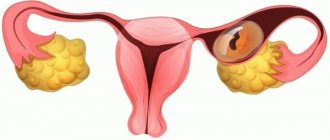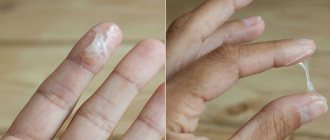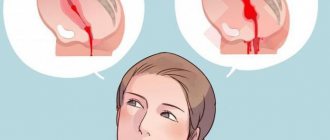After the baby comes out, a bleeding wound forms on the surface of the uterus, from which blood, placenta particles, clots and remnants of the fetal membrane eventually come out. At this moment, the uterus contracts intensively and removes everything unnecessary. Doctors call this process lochia, it lasts several weeks and resembles menstrual periods.
A young mother should not be afraid of such a phenomenon. Upon completion, the uterus will return to its previous size, and the separation of fluids will stop after a while. Lochia initially has a bright scarlet tint without an odor, and in recent days it becomes creamy or transparent. But sometimes a girl may notice green discharge after childbirth, which may indicate the presence of disorders and abnormalities.
Reason for appearance
A number of the following factors provoke a similar illness in the form of a green tint:
- infectious diseases;
- the presence of inflammatory processes in the uterus due to injury or incomplete release of the fetal membrane;
- the process of suppuration due to the accumulation of discharge after cesarean section.
This sign can mean dangerous consequences, so
It is necessary to urgently seek help from a specialist and not self-medicate.
Distinctive features of a caesarean section
The opinion is erroneous that loose lochia in the case of natural delivery is not much different from that caused by cesarean delivery. This is not true at all. There are some differences. Caesarean is still an operation.
The likelihood of developing inflammation increases several times. It is extremely important for women not to neglect hygiene measures after a cesarean section, as it is a rather crude surgical intervention; moreover, the healing process of the uterine cavity takes much longer.
The main differences between a caesarean section and a natural birth:
- the presence of a large amount of mucus (clumps) in the composition in the first 2-4 days;
- the abundance of lochia secreted in the first 5-7 days is bright red in color with a gradual transition to brown;
- protracted discharge due to poor contraction of the uterus and healing of the wounded surface;
- discharge of a juicy, rich red tone of discharge , which is also quite normal.
It is normal for discharge after cesarean to last no more than 2 weeks. A prolonged nature may indicate the development of an inflammatory process, but the extent of the wound and blood clotting also play a role.
Young mothers should not be afraid of such changes in the body if the birth went well and there are no signs of complications. The uterine mucosa must fully recover due to cesarean section and this requires some time. The main thing is to promptly notice possible pathological manifestations and consult with a gynecologist at the initial stage.
What do the symptoms mean?
Green lochia indicates malfunctions and are quite dangerous for the mother’s health. Under no circumstances should you ignore a visit to the doctor. A similar shade of secreted fluid indicates the presence of pus in it. This symptom is often accompanied by a rotten odor from the vagina, as well as itching and burning. This causes extreme inconvenience for the girl in everyday life.
Green discharge in women after the birth of a child may indicate the appearance of serious and sometimes dangerous diseases.
If greenish discharge is accompanied by high fever and pain, medical professionals suspect endometritis. This disease manifests itself as poor health and is extremely difficult to treat.
Read also Do female genital organs become larger before and after childbirth - Fears and myths
A sluggish form of endometritis can be suspected when green discharge makes itself felt after childbirth after 2 months or a month later. The girl may not feel any discomfort, but in this case it is necessary to consult a diagnostician.
Greenish discharge may indicate several other diagnoses:
- gonorrhea;
- trichomoniasis;
- chlamydia;
- gardnerellosis;
- thrush.
In order to accurately understand the cause of the light yellow-greenish discharge and make the correct diagnosis, you need to consult an experienced gynecologist and undergo a series of examinations.
Discharge after cesarean section appears very often among women in labor. This problem arises due to the inability of the uterus to contract intensively and remove excess fluid. As a result, clots, blood, and tissue particles remain inside and the process of putrefaction begins. During this period, the mother may also be bothered by painful trips to the toilet, as well as itching, redness and irritation of the mucous membrane of the intimate area.
Green discharge after childbirth
Carrying and giving birth to a baby is a difficult job that affects the condition of the mother’s body. Immediately after childbirth, two important and interconnected processes are launched in the body - milk production and restoration of the organs of the reproductive system.
After the placenta is detached from the woman’s uterus, a wound forms in its place, and the organ itself is greatly enlarged. Gradually it contracts, and lochia is released from the woman’s vagina.
This is a liquid mass containing blood, wound secretion, mucus and remnants of membranes.
Gradually, the uterus returns to its normal size, all excess tissue leaves its cavity and liquid discharge stops. Normally, lochia does not have a distinct odor, and its color varies from blood red immediately after birth to yellowish and completely transparent at the end.
But sometimes something goes wrong and a woman discovers that the discharge has acquired a green tint. What does this mean and what to do in such a situation?
Why does green discharge appear?
The green tint of lochia is the most dangerous and should not be ignored under any circumstances. The discharge turns green if pus appears in it, and it also causes an unpleasant putrid odor. Several factors provoke its appearance:
- Inflammatory processes in the uterus caused by incomplete release of membranes or injury to the organ;
- Decay of secretions caused by their accumulation in the uterine cavity;
- Infectious diseases.
This is why it is so important to immediately go to the hospital when green lochia appears. True, serious diseases, for example, endometritis (inflammation of the uterine lining), are quite severe and acute, so mothers are forced to consult doctors. With endometritis, there is usually a significant increase in temperature and severe abdominal pain.
Sometimes large blood clots or pieces of tissue close the uterine pharynx, and the discharge cannot leave its cavity. If this problem is not solved in time, it can cause stagnation of secretions and their decay.
Sometimes green discharge does not appear immediately after childbirth, but after one and a half to two months, even after the lochia has stopped. This indicates sluggish endometritis. Even if this disease does not cause severe discomfort, it must be treated immediately.
Green discharge with a characteristic unpleasant odor, especially if its consistency resembles foam, can be a sign of gonorrhea, gardnerellosis, chlamydia, or trichomoniasis. Even thrush, which is familiar to many, can provoke such a problem. Therefore, without additional bacteriological studies it will not be possible to make a diagnosis.
In addition to green discharge, a woman may be bothered by:
- Itching and redness of the genitals due to bacterial vaginosis;
- Painful urination and pain in the lower abdomen due to chlamydia and gonorrhea;
- A mixture of blood and pus in the discharge, as well as itching and burning in the genitals with colpitis.
Treatment options
After a thorough examination, a qualified diagnostician prescribes effective methods of therapy. From the many options, you should choose the one that suits you best. Effective treatments include:
- antibiotics;
- antibacterial agents;
- antifungal drugs;
- vitamins;
- suppositories (anti-fungal or antibacterial).
In order not to harm the baby, it is recommended to stop breastfeeding during treatment.
If the case is advanced or a serious diagnosis has been made, then simply taking pills will not do. A specialist has the right to prescribe a planned operation and, through surgical intervention, remove excess tissue particles, remnants of clots and rotted tissue. Such an intervention does absolutely no harm and will only benefit the young mother. The operation takes little time, and its results appear immediately. Recovery of the body will occur much faster after such manipulation.
Norm
The normal duration of lochia is 7-9 weeks. But it is worth understanding that cesarean section leads to unnecessary damage to tissues and blood vessels.
The indicators are normal if the discharge after cesarean section:
- contain blood particles, clots;
- come off with a red scarlet hue with placenta particles;
- closer to the 8th week they become more liquid and look like light brown ointments;
- as the blood clots at 6-7 weeks, they begin to change to a brownish tint.
The smell and unusual color of lochia as a result of cesarean section may indicate serous accumulations in the uterine cavity and the development of an inflammatory process. The appearance of slight yellowness is acceptable closer to 3 weeks after the birth process, but the discharge should not have any foreign odor or impurities of pus.
Usually in the 1st week, lochia is a bright red color. Blood may flow profusely, in clots and even lumps. In the 2nd week it acquires a reddish-brown tint, and slight yellowness may also be present.
Non-pathological discharge after a cesarean section should clear up in about 7-10 days. The danger is not only their protracted nature, but also their complete absence. This means that clots accumulate in the uterus and cannot come out for some reason. It can provoke spasms and bending of the cervix.
Prevention methods
This problem can be prevented.
- Doctors recommend leading an active lifestyle. As soon as the opportunity arises, you need to move more. Movement will provoke improved blood circulation and speed up the release of everything unnecessary. A woman who has just given birth should not ignore this rule. It is not necessary to visit the gym and exhaust yourself; walking with a stroller during the day is quite suitable for this purpose.
- It is important not to forget about the rules of personal intimate hygiene. Doctors strongly advise rinsing the vagina with warm boiled water or a herbal decoction after each visit to the restroom. For this purpose, it is better to use herbs against skin irritation; chamomile, sage, and calendula work well. Also, do not forget about regularly changing hygiene products (postpartum pads). Failure to promptly change such products may cause the development of bacteria or microbes.
- While taking a shower, you need to temporarily forget about fragrant gels and foams. It is better to give preference to antibacterial products without fragrances and dyes.
- It is also necessary to wear underwear made from natural fabrics (cotton), and ignore synthetics.
- It is extremely important for a girl to visit a gynecologist in a timely manner and report all suspicions and unpleasant symptoms.
Read also Childbirth with poor vision: is there a risk of loss? What affects vision?
You need to listen to the advice of medical professionals and get diagnosed on time, since self-medication can only worsen the well-being of a young mother.
Deviations
A deviation due to a cesarean section is considered to be a short period of discharge - less than 6 weeks or a prolonged period - more than 10 weeks. It is acceptable to increase the period by 1 week, taking into account the individual characteristics of the body. The main thing is to take into account the color, smell and composition of lochia in order to suspect a problem in time and solve it together with doctors.
Of course, surgery leads to severe damage to the uterine cavity; oozing contents from injured areas can be quite long-lasting.
If inflammation develops, we are talking about the penetration of infection, when it may be necessary to re-clean the uterus. Lochia that continues for a long time is an alarm bell, especially with the discharge of foul-smelling ichor.
It is important for women to know the sequence of lochia discharge in order to notice deviations in time against the background of a cesarean section:
- discharge of a bright red color with lumps and blood clots;
- change of red discharge to a darker color;
- gradual change to a brown, dark brown shade;
- change to a yellowish color, eventually to colorless.
Many young mothers believe that lochia comes off in smaller quantities after a cesarean section. It is a myth. Volume cannot affect the type of delivery. The discharge can be copious and prolonged, often after surgery.
A word from the experts
Doctors say that after childbirth, discharge with an unpleasant odor may be normal. After all, the placenta was in the reproductive organ for a long time, and now it has separated from its wall. Along with bloody discharge, its remains come out. They do not always have a neutral smell. Often women complain about a specific “aroma”.
In most cases, this situation does not require any intervention. Experts recommend putting your baby to the breast more often to improve blood flow. After all, lactation promotes rapid contraction of the uterus. Also, in some cases, a woman is prescribed medications, for example, Oxytocin.
Doctors advise lying on your stomach more in the first days after giving birth. This improves the flow of blood from the reproductive organ. It is also necessary to monitor the regularity of bowel movements. You need to empty your bowels 1-2 times a day. If you can’t do this on your own, then you need to use medications. If you experience discharge with an unpleasant odor after childbirth, you should see a doctor as soon as possible. Let's consider the main causes of the symptom.
When should you contact a doctor?
You should contact a doctor immediately if the following symptoms appear:
- abrupt cessation of secreted lochia;
- prolonged duration of discharge accompanied by aching in the lower back, pain in the uterus;
- temperature increase;
- abdominal pain;
- unnatural shade of discharge;
- the appearance of a putrid odor, pus, green, cheesy mass combined with itching, burning in the genitals;
- discharge of copious yellow discharge with an unpleasant smell of rotten fish in the vagina if dysbacteriosis is suspected.
Of course, the specific characteristics of the body play a big role.
However, the appeal should be when:
- excessively short lochia with a duration of less than 5 weeks;
- long, over 8 or more weeks.
When a foreign odor appears, endometriosis often develops, which is fraught with complications and unpleasant consequences.
Signs you can't ignore:
- hyperemia of the mucous membrane;
- discharge of purulent ichor;
- the appearance of an unusual color of discharge with the smell of glue
It is important to understand that sutures can take quite a long time to heal and improper care or lack of hygiene for the uterine cavity can lead to suppuration, infection, and the development of inflammation. The appearance of swelling, itching in the vagina, and the discharge of purulent serous discharge with a foul odor cannot be ignored.
Summarize
If after childbirth you suddenly have discharge that has an unpleasant odor, you should urgently contact a gynecologist. Many women try to cope with this symptom on their own by douching. However, by doing so you are making it even worse for yourself. After all, during douching, the infection can spread to the fallopian tubes, and subsequently to the ovaries.
Doctors also do not advise taking antibacterial drugs on your own. After all, bacteria are not always the cause of symptoms. Only a specialist can determine why exactly the unpleasant smell of discharge bothers you. All the best to you and a speedy recovery!











